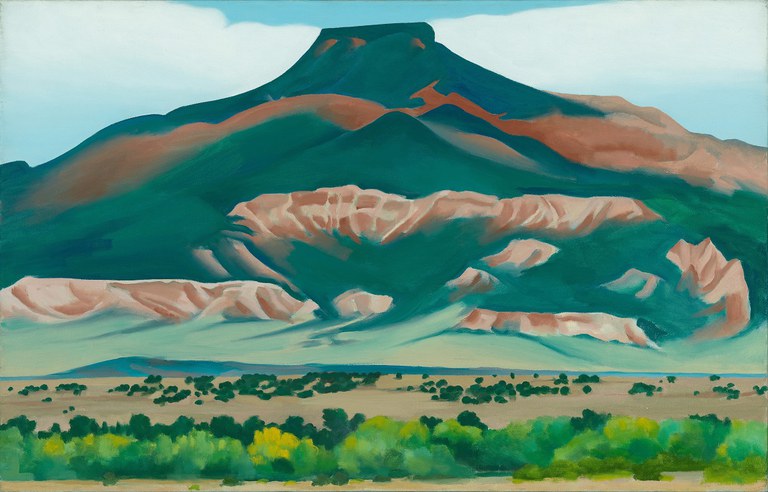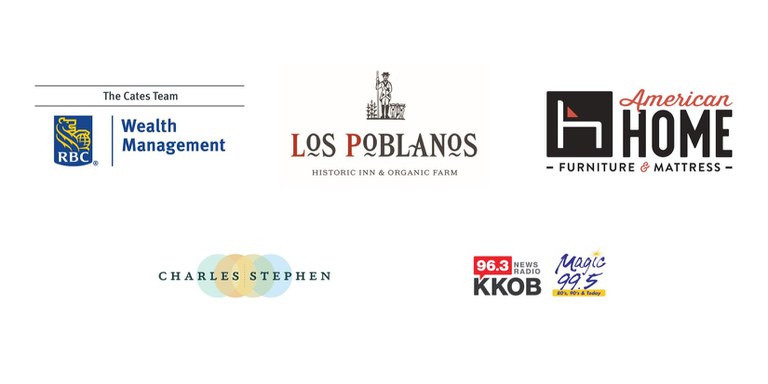O'Keeffe and Moore

Georgia O’Keeffe, Pedernal, 1941. Oil on canvas. Georgia O’Keeffe Museum, Gift of the Georgia O’Keeffe
Foundation, 2006.5.172. © 2022 Georgia O’Keeffe Museum / Artists Rights Society (ARS), New York.
A one-of-a-kind exhibition, O’Keeffe and Moore compared the work of two iconic modernists: American painter Georgia O’Keeffe and British sculptor Henry Moore.
While these artists worked on different continents, their careers and contributions to the artistic development of the 20th century reveal many parallels.
While Georgia O’Keeffe was holding up a small pelvic bone of a gray fox against the New Mexico sky, framing the landscape and imagining the curve of the bone on a vast scale, Henry Moore, eleven years her junior and half way around the world, was also holding up small bones, maquettes, and other objects against the sky, imagining them any size and peering through their apertures to the open landscape and sheep fields of Hertfordshire. The two artists pioneered and shared a coherent vision and approach to Modernism. While other Modernist artists also used natural forms as a pathway to abstraction, no other artists apart from O’Keeffe and Moore centered their art on this fundamental aspect, and amassed such great collections over their lifetimes of animal skulls and bones, gnarled tree roots and twisted driftwood, smooth and hollowed river and flint stones, internal coils of seashells and interlocking pebbles.
This exhibition united the work of these artists for the first time, and re-created their studios in the Museum with their original contents of found objects, tools, and furnishings. Visitors explored their working practices to how these humble objects inspired some of their most important artistic creations.
Over 100 paintings and sculptures traced their artistic development, exploring Surrealist concepts such as the pairing of objects and metamorphosis, as well as their investigations of bones, stones, internal/external forms of flowers and seashells, and landscape. Before settling permanently in New Mexico, O’Keeffe collected animal skulls she found during visits to the Southwest, bringing them back with her to New York to study and paint. Meanwhile, Moore referred to his maquette studio as his “library of natural forms” and drew from its vast resources daily, fusing the shapes of the human figure in plaster and terra cotta with those of the natural world, and questioning our relationship with the environment. He mused “The value of certain types of modern sculpture may be that it opens people’s eyes to nature, that they pick up things which they wouldn’t look at otherwise; and they look at things with a new eye.” The sentiment is echoed in the reminiscences of O’Keeffe: “I have picked flowers where I found them. I have picked up sea shells and rocks and pieces of wood where there were sea shells and rocks and pieces of wood that I liked…I have used these things to say what is to me the wideness and wonder of the world as I live in it.”
In 1986 both Modernist icons passed away and with their passing came the end of a watershed artistic era. The artists met in 1946 during Moore’s retrospective at the Museum of Modern Art in New York. O’Keeffe had her retrospective there, MoMA’s first of a woman artist, only a few months earlier.
Above all, the common ground between these two artists can be found in the inspiration each took from nature and their enduring association with the landscapes that were an essential part of their life’s work. Moore relocated from London to the verdant sheep fields of Hertfordshire during the Blitz in 1940, while O’Keeffe left the bustle of New York to settle permanently in New Mexico in 1949, becoming inextricably linked to the striking desert terrain. This exhibition has been assembled from national and international collections, including masterpieces from the intimate to the monumental in scale, and in materials ranging from paintings to bronze, as well as travertine, lead, elmwood, lignum vitae, and even stalactite.
Curated by Anita Feldman, The San Diego Museum of Art’s Deputy Director for Curatorial Affairs and Education, the exhibition was accompanied by a beautifully illustrated catalogue with contributions from leading international scholars.
O’Keeffe and Moore was organized by the San Diego Museum of Art in collaboration with Albuquerque Museum, Henry Moore Foundation, and The Georgia O’Keeffe Museum. This exhibition was supported by an indemnity from the Federal Council on the Arts and the Humanities.
This exhibition was proudly sponsored by our generous corporate partners:

